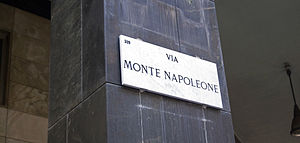
The Galleria Vittorio Emanuele II is Italy's oldest active shopping gallery and a major landmark of Milan. Housed within a four-story double arcade in the centre of town, the Galleria is named after Victor Emmanuel II, the first king of the Kingdom of Italy. It was designed in 1861 and built by architect Giuseppe Mengoni between 1865 and 1877.
Paninaro was a social phenomenon in northern Italy during the 1980s that was characterized by an obsession with designer clothing and adherence to a lifestyle based on luxury consumption. It began in the Milanese metropolitan area, later spreading throughout continental Italy. The phenomenon led to the creation of magazines, films and television programs.
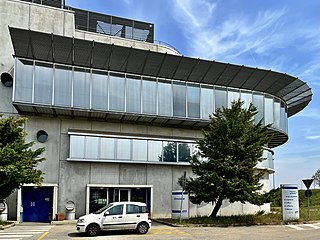
The Gruppo Torinese Trasporti (GTT) is a public benefit corporation responsible for public transportation in the provinces of Alessandria, Cuneo, Asti and the Metropolitan City of Turin. It was created in 2003 from the merge of ATM and SATTI, the latter responsible for railway connection in the province of Turin as well as for the Turin metro. GTT is now wholly owned by the Turin City Hall.

Piazza San Babila is a city square in Milan, Italy.
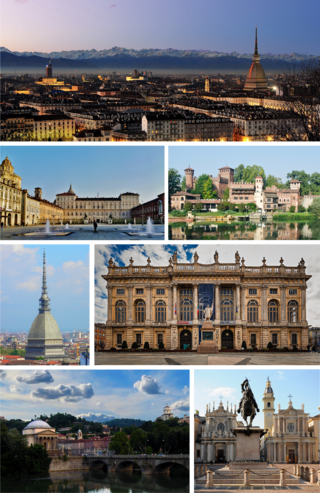
Turin is a city and an important business and cultural centre in Northern Italy. It is the capital city of Piedmont and of the Metropolitan City of Turin, and was the first Italian capital from 1861 to 1865. The city is mainly on the western bank of the Po River, below its Susa Valley, and is surrounded by the western Alpine arch and Superga hill. The population of the city proper is 843,514, while the population of the urban area is estimated by Eurostat to be 1.7 million inhabitants. The Turin metropolitan area is estimated by the OECD to have a population of 2.2 million.
Italy is one of the leading countries in fashion design, alongside France and the United Kingdom. Fashion has always been an important part of the country's cultural life and society, and Italians are well known for their attention to dress; la bella figura, or good appearance, retains its traditional importance.

Milan is the capital of the Lombardy region in northern Italy and is the wealthiest city in Italy. Milan and Lombardy had a GDP of €400 billion and €650 billion respectively in 2017. Milan surpassed Berlin in the size of its economy in 2014, and has since been the richest city among the Four Motors for Europe. It is a member of the Blue Banana corridor among Europe's economic leaders.

Corso Buenos Aires is a major street in north-eastern Milan, Italy. With over 350 shops and outlets, it features the highest concentration of clothing stores in Europe. The architecture of the area is mostly late 19th- and 20th-century style; the street and its surroundings are pointed with several neo-classical and art nouveau buildings.

Having been ruled by several countries over the centuries, Milanese culture is eclectic and borrows elements from many other countries, including Austria, Spain and France. Similarities between these places and Milan can be noticed through the language, architecture, cuisine and general culture of these countries.

The history of Italian fashion is a chronological record of the events and people that impacted and evolved Italian fashion into what it is today. From the Middle Ages, Italian fashion has been popular internationally, with cities in Italy producing textiles like velvet, silk, and wool. During the Middle Ages and Renaissance, Italian fashion for both men and women was extravagant and expensive, but the fashion industry declined during the industrialization of Italy. Many modern Italian fashion brands were founded in the late 19th and early 20th centuries, and in the 1950s and 1960s, Italian fashion regained popularity worldwide. While many clients of Italian fashion designers are celebrities, Italian fashion brands also focus on ready-to-wear clothes.

Porta Vittoria was a city gate in the Spanish walls of Milan, Italy. While the walls and the gate have been demolished, the name "Porta Vittoria" has remained to refer to the district ("quartiere") where the gate used to be. This district is part of the Zone 4 administrative division of Milan.

Porta Romana is a former city gate of Milan, Italy. In its present form, the gate dates back to the 16th century Spanish walls of Milan. Its origins can be traced further back to the Roman walls of the city, which had a corresponding "Roman Gate" roughly in the same area. Porta Romana was the first and the main imperial entrance of the entire city of Milan, as it was the starting point of the road leading to Ancient Rome.
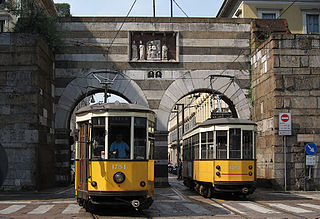
The Milan tramway network is part of the public transport network of Milan, Italy, operated by Azienda Trasporti Milanesi (ATM).

The Zone 1 of Milan, since 2016 officially Municipality 1 of Milan, is one of the 9 administrative divisions of Milan, Italy.
Brian & Barry is an Italian department store chain, which operates the flagship store and corporate headquarters near Piazza San Babila, central Milan. Brands sold include a number of high-end labels as well as Brian & Barry private label merchandise.
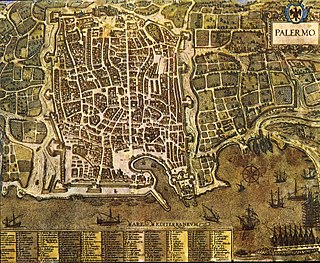
The Cassaro is the most ancient street of Palermo. From the late 16th century the street also had the name Via Toledo. Following the unification of Italy, it was officially renamed Via Vittorio Emanuele II, but the old and distinctive name is still in use. The street is rooted in the age of the foundation of Palermo by the Phoenicians. It provides access to a number of important sights, including the Royal Palace and the Cathedral, two UNESCO World Heritage Sites.

The following outline is provided as an overview of and topical guide to Milan:

The Galleria del Corso is a major shopping arcade in the historic center of Milan, Italy, one of five built in the city in the interwar period (1919–39), along with the Galleria del Toro, Galleria Mazzini, Galleria Meravigli and the Galleria Gonzaga.

Piazza del Liberty is a pedestrian square located along Via San Paolo, one block north of the Corso Vittorio Emanuele II, some 3 blocks north east of the Duomo in central Milan, region of Lombardy, Italy. The piazza was created in part in the space after the destruction of the Teatro Milanese during the Allied bombardment in 1943, and takes its name from the Art Nouveau facade decoration of one of its buildings. It is now complemented by chic shops and modern fountains.
